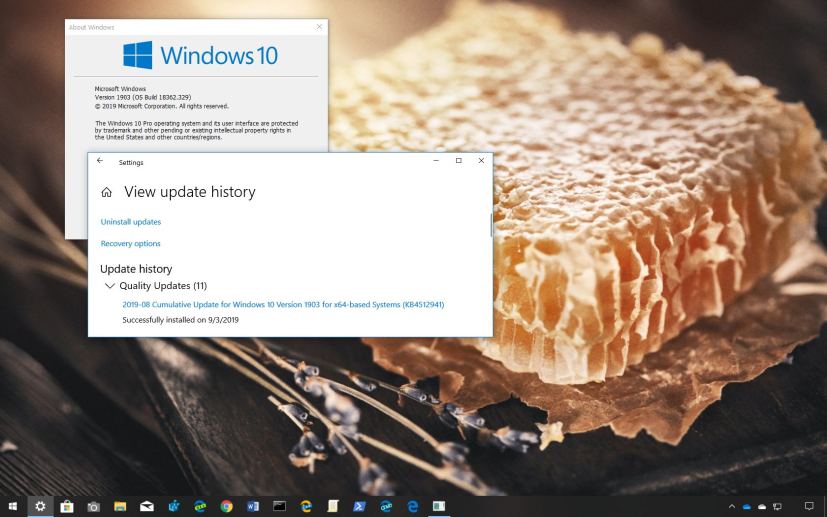Outside of its regular Patch Tuesday schedule, Microsoft made available update KB4512941 for devices running Windows 10 version 1903, May 2019 Update, on August 30, to address a number of issues.
KB4512941 bumps the version number to build 18362.329, and according to the company fixes issue that prevents certain games from using Spatial Audio. Addresses problem that fails to provide a cursor when you select a text input box using touch. It also fixes issue that may cause the name of an unsupported application to appear as default text (such as “ms-resource:AppName/Text”) in the Start menu after an upgrade. And improves experience and app compatibility so that more Win32 apps will work with Windows Mixed Reality.
Update KB4512941 for Windows 10 version 1903
Microsoft has announced KB4512941 in the Windows support site, and it’s referred as “August 30, 2019—KB4512941 (OS Build 18362.329)” If you’re already running the Windows 10 May 2019 Update on your device, this update will address these problems:
- Addresses an issue that displays a black screen when you use Remote Desktop to connect to a machine running Windows 10, version 1903.
- Fixes a problem that may prevent the Windows Sandbox from starting with the error, “ERROR_FILE_NOT_FOUND (0x80070002).”
- Addresses an issue that prevents some Trusted Platform Module (TPM) devices from being used for Next Generation Credentials.
- Fixes a problem that fails to provide a cursor when you select a text input element using touch.
- Addresses an issue that may cause the name of an unsupported application to appear as default text, such as “ms-resource:AppName/Text” in the Start menu after upgrading the operating system.
- Improves the user experience and app compatibility so that more Win32 apps will work with Windows Mixed Reality.
- Fixes a problem that leads to excessive memory utilization in Windows Defender Advanced Threat Protection (ATP).
- Addresses an issue that prevents Windows Defender Advanced Threat Protection (ATP) from running automated forensic data collection when using registry-based proxy configuration.
- Fixes a problem that prevents Windows Defender Advanced Threat Protection (ATP) from sending cyberspace events for paths beginning with \\tsclient.
- Addresses a possible compatibility issue when Windows Defender Advanced Threat Protection (ATP) accesses case-sensitive Server Message Block (SMB) shares.
- Addresses a rare issue that occurs when the mssecflt.sys driver takes too much space on the kernel stack. This results in the error, “STOP 0x7F: UNEXPECTED_KERNEL_MODE_TRAP”, and Parameter 1 is set to “EXCEPTION_DOUBLE_FAULT.”
- Addresses an issue that causes a workstation to stop working when you sign in using an updated user principal name (UPN).
- Increases the number of supported interrupts per device to 512 on systems that have x2APIC enabled.
- Improves the detection accuracy of Microsoft Defender ATP Threat & Vulnerability Management.
- Fixes a problem in which Windows Defender Application Control will not allow third-party binaries to be loaded from a Universal Windows Platform application.
- Addresses an issue that causes devices to have truncated device names when Autopilot provisioning automatically assigns a name to them.
- Fixes a problem in which the product description of Windows Server 2019 was incorrect when queried using slmgr /dlv.
- Addresses an issue that causes the Windows Management Instrumentation (WMI) class Win32_PhysicalMemory to report that 32GB memory chips have a missing Capacity value.
- Fixes a problem that prevents you from copying and pasting compound documents (formerly OLE objects) between an application that hosts the RichEdit control and other applications.
- Addresses an issue that prevents certain games from leveraging Spatial Audio capabilities.
- Fixes a problem that may prevent the personal identification number (PIN) prompt from appearing when authenticating in Internet Explorer.
- Addresses an issue with downloading digital rights management (DRM) files from certain websites using Microsoft Edge and Internet Explorer.
- Fixes a problem with LdapPermissiveModify requests, which fail to make Active Directory (AD) group membership changes if the Lightweight Directory Access Protocol (LDAP) client uses the Security Identifier (SID) syntax.
- Addresses an issue that may prevent devices from starting when they start up using Preboot Execution Environment (PXE) images from Windows Deployment Services (WDS) or System Center Configuration Manager (SCCM).
- Fixes a problem that may prevent devices from starting up or cause them to continue restarting if they are connected to a domain that is configured to use MIT Kerberos realms. Domain controllers and domain members are both affected.
- Addresses an issue that may stop responding apps that were made using Visual Basic 6 (VB6), macros that use Visual Basic for Applications (VBA), and scripts or apps that use Visual Basic Scripting Edition (VBScript). And you may also receive an “Invalid procedure call” error.
Download August 2019 update for Windows 10
The update available immediately, it’ll eventually download and install automatically, but you can always force the update from Settings > Update & Security > Windows Update and clicking the Check for updates button. You can find more details about the most recent updates in the Windows 10 update history tracker guide.
You can download the updates to install them manually with the links below:
Update September 7, 2019: You should be careful installing this update as the update includes a known issue that may break the search functionality and Start menu if you have previously disabled Bing results for Windows Search.
Update September 13, 2019: Microsoft has fixed the high CPU usage with the SearchUI.exe process with update KB4515384, but this new update also introduce other problems with the Start menu and search. As such, it’s recommended to avoid installing KB4512941 and KB4515384 until further notice.

